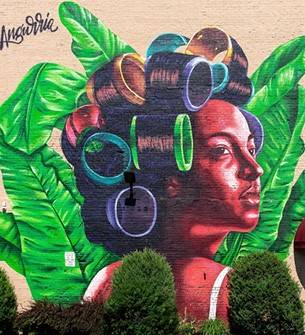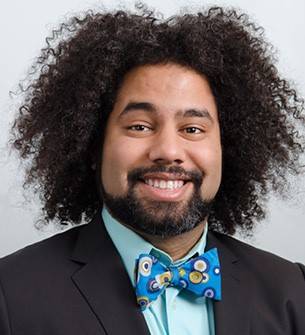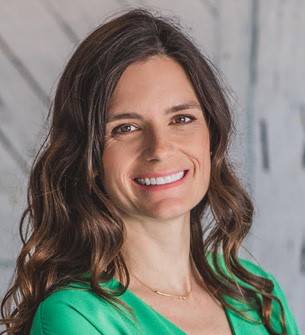A radiologist at Massachusetts General Hospital organizes art installations throughout the hospital’s buildings.
- A radiologist saw an opportunity to showcase diverse art, allowing the hospital to better engage with patients and make its spaces more inclusive.
- He partnered with colleagues and a local nonprofit organization to create an art exhibit that reflects the community that the hospital serves.
- With thoughtful art displayed, the hospital’s community centers create empathy among staff and combat health disparities.
Large pictures of brightly colored murals hang throughout the building. One features the owner of a local yoga studio watering her flowers; she’s framed by an enormous lace doily. Another features a Latina woman facing away from the camera, a rooster on her shoulder and an aloe plant in her hand — symbols of protection and healing. A third shows a Black child playing the violin as sparrows fly out of a broken vase.
These works are part of The People’s heART , a physician-led art program that works with local, national, and international artists to create installations that rotate throughout MGH’s three community health centers. “Our goal is to reimagine healthcare spaces to better reflect and serve the rich diversity of our patients, staff, and community,” says Daniel Chonde, MD, PhD, founder and executive director of The People’s heART.
 This mural, called Doña Patria by Evaristo Angurria, is located in Lynn, Massachusetts. A large print of the mural now hangs in one of MGH’s community health centers thanks to The People’s heART project. |
The art installations are specifically curated to reflect these populations, promoting greater inclusivity and health equity, Chonde says. “We want to use art to help community members feel more connected to our facilities,” he says. “Research shows that when patients feel represented, they are more likely to engage more fully in their care, leading to better outcomes.”2
Building Empathy
Although art might seem unrelated to health equity, Chonde says there is a deep connection — and it all comes down to empathy. “Neuroaesthetics is a somewhat new field in which researchers examine how our brains interpret art and how art evokes emotions,” he explains. “Mirror neurons play a large role in a person’s empathetic response. They’ve found that viewing art activates those same neuron groups, meaning art can evoke empathy. And a more cross-culturally empathetic workforce translates to a better experience for all patients.”3Recognizing this, The People’s heART team curated one of its latest installations with the Off the Grid project. Off the Grid was a collaboration between community volunteers and the project included community volunteers who worked with the Lynn Shelter Association that provided individuals experiencing homelessness photography training to help them tell their stories and develop career skills. The People’s heART exhibit, also entitled “Off the Grid,” features a portion of the 6,000 photos captured as part of the project.
Chonde says that this exhibit has been important for helping hospital staff at MGH better understand patients who experience homelessness. “Individuals experiencing homelessness are often frequent visitors to emergency rooms, so many providers tend to view them as trouble or challenging,” he explains. “But when staff walk past these photos every day and learn that they’re created by individuals experiencing homelessness, a connection forms between the staff member and the art and by extension the person who made the images. So, there’s a chance that the next time they treat an individual experiencing homelessness, they’ll remember those photos, which in turn will drive their response — hopefully to a more empathetic one.”
Making healthcare spaces more welcoming is also an important part of health equity, adds Megan Carleton, ATR-BC, LMHC, artistic director of The Peoples’ heART. “People from underserved communities typically distrust medical institutions due to historic mistreatment, which drives health disparities as these patients often eschew medical care,” she explains. “Intentionally selected art can have a positive impact on patients, families, and medical staff. It can enhance the environment of care, reduce stress, improve mood, provide a distraction from medical problems, and even offer respite from workplace stressors. By making healthcare spaces more welcoming and relatable, we can attract patients who may have previously avoided them.”
Brightening Spaces
Chonde began thinking about making spaces more welcoming during the height of the COVID-19 pandemic in 2020. To respond to the outbreak, MGH created respiratory infection clinics in some of its community health centers. These clinics provided patients with outpatient care rather than requiring them to go to a crowded emergency room.Chonde was working in the Chelsea HealthCare Center when he noticed how disconnected it seemed from the community. The virus hit Chelsea, which has been traditionally underserved and more socioeconomically disadvantaged than other Boston areas, particularly hard. “We were in a bleak office building tucked away in an industrial complex. If there was any decoration in the space, it was bland and had been sitting there for years,” Chonde explains. “As I looked around the facility, I felt like we weren’t fully contributing to the betterment to the community. I saw an opportunity to connect the center more closely with the community, and I wanted to find a way to make that happen.”
 Daniel Chonde, MD, PhD, founded The People’s heART in an effort to make an impact on the local community surrounding MGH Community Centers. |
As Chonde worked on his proposal, however, he learned more about how decorations are typically chosen for healthcare spaces. Hospital aesthetics in the U.S. are largely based on a study conducted by Roger Ulrich at a suburban Pennsylvania hospital between 1972 and 1981. Ulrich concluded that art should be chosen based on improving patient outcomes rather than on praise from critics — and that natural works, such as landscapes, night skies, or pictures of vegetables performed the best, as patients who were exposed to nature seemed to experience less stress and improve more quickly.4
But, Chonde notes, there are a couple of problems with that research: The study was small, and the population involved was homogenous and excluded factors related to diversity. “They never really accounted for any differences in race, religion, or sexuality,” Chonde says. “What has come to pass is this corporate, Eurocentric idea of art that doesn’t necessarily evoke emotion or connection because the culture has been taken out of it. So, I started thinking, what if we put our local culture back in to our art?”
Finding Partners
With that idea in mind, Chonde began looking for partners to create a proposal. “I knew the equity and business side of things, but I needed someone who understood the art world better,” he says.Chonde searched for MGH colleagues who might be interested in the project and found Carleton, an art therapist who managed the Illuminations art collection for the MGH Cancer Center. A licensed mental health counselor and art therapist, Carleton has experience managing rotating art exhibits and understands how art can affect patients in healthcare settings.
Carleton was excited about the proposal. “Dan had the idea and the rationale so well thought out from his own lived experience of working in the centers during the pandemic to the research he had already pulled that showed support for arts in healthcare settings and the need for updated, more inclusive data. I know from working one-to-one with patients as an art therapist how uncomfortable people can feel in a medical setting and from my role as hospital art curator what a positive influence the right art can have on a patient’s experience of the medical visit,” she says.
Chonde also needed local art for the first installation and set out to find a community partner who could serve as a liaison to artists in the community and help him find suitable art for the exhibit. When Chonde heard Al Wilson, the founder of Beyond Walls , speak during an event celebrating Juneteenth, a day that commemorates the emancipation of enslaved people in the U.S., for MGH’s radiology department, he knew that the organization would be the perfect collaborator.
Beyond Walls places art installations, such as murals and urban design projects, throughout the city of Lynn and additional gateway cities to enhance the physical landscape, drive positive economic change, and bolster community engagement. “We’ve worked with a lot of artists that reflect the cultural identities of the communities we serve, which was part of the goal for The People’s heART,” Wilson explains. When Chonde approached him with the idea of placing pictures of Beyond Walls murals in the hospital, Wilson quickly agreed. “It’s important for medicine to show it’s serving all walks of life. I hoped our murals could help humanize the practice and hopefully break down some of the mistrust of medicine,” he says.
Wilson provided large photographs of murals that Beyond Walls artists had already placed around Lynn. The murals focus on aspects of the artists’ heritage and experiences during the COVID-19 pandemic.
Creating the Proposal
With this installation in mind, Chonde and Carleton created a project proposal to submit to MGH’s Radiology Department Chair James A. Brink, MD, FACR. The proposal for The People’s heART included a literature review of the benefits of art in hospitals and emphasized how the project would support the hospital’s larger health equity campaign.“We talked about how art could serve as a multifaceted outreach approach. By showcasing art and culture important to the different populations in our community, we could reflect a culture change in the hospital system and inspire conversations about equity and diversity,” Carleton says.
 Megan Carleton, ATR-BC, LMHC, The People’s heART art director and licensed mental health and art therapist, selects art for the exhibits based on input from the communities served at their different locations. |
To reach a broader audience and expand the impact of the art, the proposal also introduced plans to create an interactive online experience that showcases the art, corresponding health equity content, and additional avenues for communication and community support. Today, viewers can scan QR codes located next to each piece of art to find out more about the piece, its cultural importance, and other pertinent information related to the exhibit.
After viewing the proposal, Brink quickly approved funding for the initial exhibit. “This was an exciting project, and I was happy to support it,” he says. “The People’s heART reinforces MGH’s desire and need to be as inclusive as possible to the diverse communities we serve, and I was excited that radiology would be the first to support such a project.”
Installing the First Exhibit
With funding for the first exhibit secured, Chonde reached out to MGH’s Office of Equity and Inclusion, which helped obtain space within the Chelsea Community Center for the artwork.Chonde and Carleton had large photographs of the murals from Beyond Walls hung throughout the center, including in waiting rooms and hallways and behind registration and check-in desks. “When we’re hanging a piece, we take into consideration the location of the exhibit space — does this piece look better in an open hallway versus a closed waiting room? We also consider the thoughts that may be running through an individual’s mind as they sit in the waiting room and take in the art,” Carleton says.
The People’s heART team has not yet formally surveyed patients or providers about the artworks’ impact. But they know it’s resonating with people. “We see groups of people nearly every time we go by an exhibit, and we’ve seen conversations on social media sparked by the art,” Chonde explains. “People are definitely paying attention.” In the future, The People’s heART will use patient satisfaction scores to gauge its success. “As we better connect with our underserved patients, we see potential for partnership in research and care delivery, which we’re hoping to quantify as well,” he says.
Carleton hopes that the artwork is helping people feel more connected to the health system. “By showcasing artwork that reflects the diversity of our patient population and workforce, our goal is to create inclusive spaces where people feel seen, heard, and welcomed,” she says.
Moving Forward
Since The People’s heART team installed its first exhibit in Chelsea, it has hung five more exhibits around MGH and has six more planned, including a collection that will feature prints from Alice Neel, a painter famous for creating portraits of members of her community, representing all races and classes, as well as political leaders, LGBTQ artists and performers, and pregnant women.The People’s heART team relies heavily on community insights to curate exhibits. “We constantly have our ears to the ground,” says Chonde, who works with community members and organizations to identify an interest or need in the different locations that MGH serves. The team also keeps in mind cultural celebrations, such as the Hindu festival of Holi, Juneteenth, National Hispanic Heritage Month, and Filipino American History Month and looks for art that corresponds with these events.
While the radiology department funded the first exhibit, support for subsequent exhibits has been raised from other departments and individuals, who are recognized on the installation’s introduction panel, art labels, and website. “We approach other chairs with a proposal similar to the one we initially presented to Dr. Brink, and so far, we’ve been pretty successful,” says Chonde, who is also pursuing research grants from philanthropic, industrial, and governmental institutions to fund a study to better understand how art resonates with patients in hospitals — but with a much more diverse group than Ulrich’s 1970s study.
Chonde hopes to eventually expand The People’s heART beyond MGH to other healthcare centers in the community. “We know art can impact how people feel,” he says. “We’d love to work with others in the community to leverage its power even further. We’re all in this community together, and we all benefit when everyone is happier and healthier.”
End Notes
1. Sacchetti, Maria. “A melting pot stretches out to the suburbs.” Boston Globe. http://archive.boston.com/news/local/massachusetts/articles/2010/12/15/ethnic_melting_pot_stretches_to_suburbs
2. Alsan M, Garrick O, Graziani G. Does diversity matter for health? Experimental evidence from Oakland. American Economic Review. December 2019. 19(12)4071-4111 10.1257/aer.20181446
3. Magsamen S. “Your Brain on Art: The Case for Neuroasthetics.” Cerebrum. 2019 Jul 1;2019:cer-07-19.
4. Ulrich R. “View through a window may influence recovery from surgery.” Science 1984;224:420–1
Share Your Story
Have a case study idea you’d like to share with the radiology community? To submit your idea please click here.Creative Commons
Promoting Diversity, Equity, and Inclusion Through Art by American College of Radiology is licensed under a Creative Commons Attribution-NonCommercial-NoDerivatives 4.0 International License . Based on a work at www.acr.org/imaging 3. Permissions beyond the scope of this license may be available at www.acr.org/Legal.Now It's Your Turn
Follow these steps to explore art and health equity in your practice, and tell us how you did at imaging3@acr.org or on Twitter at the hashtag #Imaging3 .
- Evaluate what currently hangs on your walls. Consider if it reflects your unique community and conveys your mission.
- Find people to help inform your work. Establish relationships with colleagues and local community groups, museums, academic institutions, and medical facilities. Have discussions about how you can better engage with patients in your community.
- Decide who your partners will be for the project, where the art should be hung, as well as what materials you’ll need and how much it will cost. Determine whether this project could be funded by your practice or department, or whether you’ll need sponsors.
Author
Meghan Edwards, freelance writer
Join the Discussion

#Imaging3 on Twitter
Call for Case Studies
